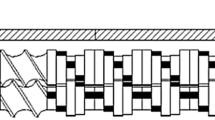Abstract
The effect of ethylene vinyl acetate (EVA) concentration and vinyl acetate (VA) content of EVA on the mechanical, morphological, and rheological properties of bio-based high-density polyethylene (BioPE)/EVA blends was investigated. The blends were characterized by X-ray diffraction, differential scanning calorimetry, scanning electron microscopy, and rheological measurements under oscillatory shear flow. The degree of crystallinity of BioPE decreased with the increase in the EVA concentration and was unaffected with the increase in the VA content. DMTA results showed a decrease in the storage modulus (E′) with the increase in EVA content and that the BioPE/EVA19 blends showed higher E′ values than BioPE/EVA28 blend. The impact strength substantially increased with the addition of EVA concentration above 5 mass% and was higher for the blends containing the highest VA content. The blends containing a higher content of VA exhibited the higher EVA dispersed phase domain size, which increased with the increase in EVA concentration. The complex viscosity increased with the increase in the EVA content, being higher for the BioPE/EVA blends containing higher VA content. The storage modulus increased, at low frequencies, with the increase in the EVA content and can be ascribed to the increase in the EVA dispersed phase domain size.








Similar content being viewed by others
References
Hamim FAR, Abdul Ghani S, Zainudin F. Properties of recycled high density polyethylene (RHDPE)/ethylene vinyl acetate (EVA) blends: the effect of blends composition and compatibilisers. J Phys Sci. 2016;27(2):23–39. https://doi.org/10.21315/jps2016.27.2.3.
John B, Varughese KT, Oommen Z, Thomas S. Melt rheology of HDPE/EVA blends: the effects of blend ratio, compatibilization, and dynamic vulcanization. Polym Eng Sci. 2010;50(4):665–76. https://doi.org/10.1002/pen.21568.
Alothman OY. Processing and characterization of high density polyethylene/ethylene vinyl acetate blends with different VA contents. Adv Mater Sci Eng. 2012;2012:1–10. https://doi.org/10.1155/2012/635693.
Zhang X, Yang H, Song Y, Zheng Q. Influence of crosslinking on crystallization, rheological, and mechanical behaviors of high density polyethylene/ethylene-vinyl acetate copolymer blends. Polym Eng Sci. 2014;54(12):2848–58. https://doi.org/10.1002/pen.2384310.1002/pen.
Na B, Zhang Q, Fu Q, Zhang G, Shen K. Super polyolefin blends achieved via dynamic packing injection molding: the morphology and mechanical properties of HDPE/EVA blends. Polymer. 2002;43(26):7367–76. https://doi.org/10.1016/S0032-3861(02)00637-7.
Savini G, Oréfice RL. Toughening high density polyethylene submitted to extreme ambient temperatures. J Polym Res. 2017. https://doi.org/10.1007/s10965-017-1243-2.
Khonakdar HA, Wagenknecht U, Jafari SH, Hässler R, Eslami H. Dynamic mechanical properties and morphology of polyethylene/ethylene vinyl acetate copolymer blends. Adv Polym Tech. 2004;23(4):307–15. https://doi.org/10.1002/adv.20019.
Khonakdar HA, Jafari SH, Yavari A, Asadinezhad A, Wagenknecht U. Rheology, morphology and estimation of interfacial tension of LDPE/EVA and HDPE/EVA blends. Polym Bull. 2005;54(1–2):75–84. https://doi.org/10.1007/s00289-005-0365-6.
Brito GF, Agrawal P, Araújo EM, Mélo TJA. Polylactide/biopolyethylene bioblends. Polímeros. 2012;22(5):427–9. https://doi.org/10.1590/s0104-14282012005000072.
Siracusa V, Blanco I. Bio-polyethylene (Bio-PE), bio-polypropylene (Bio-PP) and bio-poly(ethylene terephthalate) (Bio-PET): recent developments in bio-based polymers analogous to petroleum-derived ones for packaging and engineering applications. Polymers (Basel). 2020;12:8. https://doi.org/10.3390/polym12081641.
Iwata T. Biodegradable and bio-based polymers: future prospects of eco-friendly plastics. Angew Chem Int Ed Engl. 2015;54(11):3210–5. https://doi.org/10.1002/anie.201410770.
Chen Y, Zou H, Liang M, Cao Y. Melting and crystallization behavior of partially miscible high density polyethylene/ethylene vinyl acetate copolymer (HDPE/EVA) blends. Thermochim Acta. 2014;586:1–8. https://doi.org/10.1016/j.tca.2014.04.007.
Moly KA, Radusch HJ, Androsh R, Bhagawan SS, Thomas S. Nonisothermal crystallisation, melting behavior and wide angle X-ray scattering investigations on linear low density polyethylene (LLDPE)/ethylene vinyl acetate (EVA) blends: effects of compatibilisation and dynamic crosslinking. Eur Polym J. 2005;41(6):1410–9. https://doi.org/10.1016/j.eurpolymj.2004.10.016.
Faker M, Razavi Aghjeh MK, Ghaffari M, Seyyedi SA. Rheology, morphology and mechanical properties of polyethylene/ethylene vinyl acetate copolymer (PE/EVA) blends. Eur Polym J. 2008;44(6):1834–42. https://doi.org/10.1016/j.eurpolymj.2008.04.002.
Shi X, Jin J, Chen S, Zhang J. Multiple melting and partial miscibility of ethylene-vinyl acetate copolymer/low density polyethylene blends. J Appl Polym Sci. 2009;113(5):2863–71. https://doi.org/10.1002/app.30271.
Rajan A, Upadhyaya P, Chand N, Kumar V. Effect of nanoclay on the thermal properties of compatibilized ethylene vinyl acetate copolymer/high-density polyethylene blends. J Thermoplast Compos Mater. 2012;27(5):650–62. https://doi.org/10.1177/0892705712453157.
Khonakdar HA, Jafari SH, Haghighi-Asl A, Wagenknecht U, Häussler L, Reuter U. Thermal and mechanical properties of uncrosslinked and chemically crosslinked polyethylene/ethylene vinyl acetate copolymer blends. J Appl Polym Sci. 2007;103(5):3261–70. https://doi.org/10.1002/app.25268.
Chen Y. Investigations of environmental stress cracking resistance of HDPE/EVA and LDPE/EVA blends. J Appl Polym Sci. 2014;131(4):39880. https://doi.org/10.1002/app.39880.
Chen Y, Zou H, Liang M. Thermal, rheological, morphological and mechanical properties of high density polyethylene/ethylene vinyl acetate copolymer (HDPE/EVA) blends. Polym Sci Ser A. 2014;56(4):465–71. https://doi.org/10.1134/s0965545x14040026.
Sundararaj U, Macosko CW. Drop breakup and coalescence in polymer blends: the effects of concentration and compatibilization. Macromolecules. 1995;28:2647–57. https://doi.org/10.1021/ma00112a009.
Ma P, Hristova-Bogaerds DG, Goossens JGP, Spoelstra AB, Zhang Y, Lemstra PJ. Toughening of poly(lactic acid) by ethylene-co-vinyl acetate copolymer with different vinyl acetate contents. Eur Polym J. 2012;48:146–54. https://doi.org/10.1016/j.eurpolymj.2011.10.015.
Nagarajan V, Mohanty AK, Misra M. Blends of polylactic acid with thermoplastic copolyester elastomer: Effect of functionalized terpolymer type on reactive toughening. Polym Eng Sci. 2018;58(3):280–90. https://doi.org/10.1002/pen.24566.
Hao Y, Yang H, Pan H, Ran X, Zhang H. The effect of MBS on the heat resistant, mechanical properties, thermal behavior and rheological properties of PLA/EVOH blend. J Polym Res. 2018. https://doi.org/10.1007/s10965-018-1547-x.
Chen Y, Zou H, Liang M, Liu P. Rheological, thermal, and morphological properties of low-density polyethylene/ultra-high-molecular-weight polyethylene and linear low-density polyethylene/ultra-high-molecular-weight polyethylene blends. J Appl Polym Sci. 2013;129(3):945–53. https://doi.org/10.1002/app.38374.
Shen G, Shen H, Xie B, Yang W, Yang M. Crystallization and fracture behaviors of high-density polyethylene/linear low-density polyethylene blends: the influence of short-chain branching. J Appl Polym Sci. 2013;129(4):2103–11. https://doi.org/10.1002/app.38937.
Lee JY, Kwon SH, Chin I-J, Choi HJ. Toughness and rheological characteristics of poly(lactic acid)/acrylic core–shell rubber blends. Polym Bull. 2019;76(11):5483–97. https://doi.org/10.1007/s00289-018-2662-x.
Acknowledgements
The authors thank CAPES and CNPq for financial support.
Author information
Authors and Affiliations
Corresponding author
Additional information
Publisher's Note
Springer Nature remains neutral with regard to jurisdictional claims in published maps and institutional affiliations.
Rights and permissions
About this article
Cite this article
Farias, G.M.G., Agrawal, P., Hanken, R.B.L. et al. Effect of EVA copolymer containing different VA content on the thermal and rheological properties of bio-based high-density polyethylene/ethylene vinyl acetate blends. J Therm Anal Calorim 146, 2127–2139 (2021). https://doi.org/10.1007/s10973-020-10423-5
Received:
Accepted:
Published:
Issue Date:
DOI: https://doi.org/10.1007/s10973-020-10423-5



